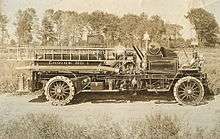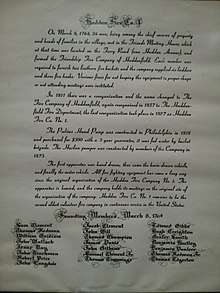Fire department
A fire department (American English) or fire brigade (British English)[note 1], also known as a fire protection district, fire authority or fire and rescue service is an organization that primarily provides firefighting services for a specific geographic area. Fire departments are most commonly a public organization who operate within a municipality, county, state, nation, or special district. Private and specialist firefighting organizations also exist, such as those at airports.
A fire department contains one or more fire stations within its boundaries, and may be staffed by career firefighters, volunteer firefighters, drafted firefighters, paid on-call firefighters or a combination thereof (referred to as a combination department).[1]
A fire department may also provide fire protection or fire prevention services, whereby firefighters visit homes and give fire safety advice and fit smoke alarms for members of the public. In many countries, fire protection or prevention is seen as an important role for the fire service, as preventing a fire from occurring in the first place can save lives and property. Fire departments also employ fire investigators. In some places such as large US cities, it is common for the fire department to run the emergency medical service, which requires more frequent call-outs than firefighting.
Organization
Fire departments are organized in a system of administration, services, training, and operations; for example:

- Administration is responsible for supervision, budgets, policy, and human resources.
- Service offers protection, safety, and education to the public.
- Training prepares skilled people with the knowledge to perform their duties.
- Operations performs the tasks to successfully save the public from harm.[2]
A fire service is normally set up where it can have fire stations and sophisticated fire engines strategically deployed throughout the area it serves, so that dispatchers can send fire engines, fire trucks, or ambulances from the fire stations closest to the incident. Larger departments have branches within themselves to increase efficiency, composed of volunteers, support, and research.
- Volunteers give advantages to the department in a state of emergency.
- Support organizing the resources within and outside of the department.
- Research is to give advantages in new technologies for the department.
Jurisdiction
Most places are covered by a public sector fire department, which is established by a local or national government and funded by taxation. Even volunteer fire departments may still receive some government funding.
The typical size of a fire department varies greatly by country. In the United States, firefighting is usually organized on a municipal level. Some municipalities belong to "fire protection districts" that are served by the same fire department, such as the San Ramon Valley Fire Protection District. Germany and Canada also organize fire services at a municipal level. In France, fire services mostly cover one department. In the United Kingdom, most fire services cover one or more counties, while Scotland and Northern Ireland have a single fire service each. In Australia, state governments run the fire services, although three states have separate agencies for metropolitan and rural areas. Israel and New Zealand have national fire and rescue services.
Responsibilities
Besides fires, fire departments respond to a variety of emergencies such as haz-mat situations, floods and structural collapses. They may also have urban search and rescue units.
In many countries or regions (e.g., the United States, Germany, Japan, Hong Kong, Macau), fire departments are often responsible for providing emergency medical services. Firefighters are cross-trained as emergency medical responders, emergency medical technicians, or paramedics. While some services act only as "first responders" to medical emergencies and traffic collisions, stabilizing victims until an ambulance can arrive, other fire services also operate ambulance services.
History



Ancient Rome
The earliest known firefighting service was formed in Ancient Rome by Marcus Egnatius Rufus who used his slaves to provide a free fire service.[3] These men fought fires using bucket chains and also patrolled the streets with the authority to impose corporal punishment upon those who violated fire-prevention codes. The Emperor Augustus established a public fire department in 24 BCE, composed of 600 slaves distributed amongst seven fire stations in Rome.[4]
1600s and 1700s
Fire departments were again formed by property insurance companies beginning in the 17th century after the Great Fire of London in 1666. The first insurance brigades were established the following year.[5] Others began to realize that a lot of money could be made from this practice, and ten more insurance companies set up in London before 1832: The Alliance, Atlas, Globe, Imperial, London, Protector, Royal Exchange, Sun Union and Westminster.[6] Each company had its own fire mark, a durable plaque that would be affixed to the building exterior. A company's fire brigade would not extinguish a burning building if it did not have the correct fire mark.[7]
Amsterdam also had a sophisticated firefighting system in the late 17th century, under the direction of artist Jan van der Heyden, who had improved the designs of both fire hoses and fire pumps.[8]
The city of Boston, Massachusetts established America's first publicly funded, paid fire department in 1679.[9][10] Fire insurance made its debut in the American colonies in South Carolina in 1736, but it was Benjamin Franklin who imported the London model of insurance. He established the colonies' first fire insurance company in Philadelphia named the Philadelphia Contributionship,[5] as well as its associated Union Volunteer Fire Company, which was an unpaid (volunteer) company.[11]
In 1754,[12] Halifax, Nova Scotia established the Halifax Regional Fire and Emergency, which is today Canada's oldest fire department.

In 1764, Haddonfield, New Jersey established the second oldest fire company in the United States.
In 1773, the city of Petersburg, Virginia established one of the first fire departments in the United States[13][14] and it was also made up of unpaid volunteers[15]
1800s
In the 19th century, the practice of fire brigades refusing to put out fires in buildings that were uninsured led to the demand of central command for fire companies.[16]Cities began to form their own fire departments as a civil service to the public, obliging private fire companies to shut down, many merging their fire stations into the city's fire department. In 1833, London's ten independent brigades all merged to form the London Fire Engine Establishment (LFEE), with James Braidwood as the Chief Officer.[17] Braidwood had previously been the fire chief in Edinburgh, where the world's first municipal fire service was founded in 1824, and he is now regarded, along with Van der Heyden, as one of founders of modern firefighting.[8] The LFEE then was incorporated into the city's Metropolitan Fire Brigade in 1865 under Eyre Massey Shaw.
Established in 1853, the Cincinnati Fire Department is the oldest paid fully professional municipal fire department in the United States.[18]
In 1879, Notre Dame University established the first University-based fire department in the United States [19]
1900s
In 1906, the first motorized fire department was organized in Springfield, Massachusetts, after Knox Automobile of Springfield produced the first modern fire engine one year earlier.[20]
See also
References
- ↑ In the United States, a "fire brigade" is the private firefighting organization of a company or enterprise, operated under rules from OSHA.
- ↑ Cote, Arthur E. (2003). "Basics of Fire and Fire Science". Organizing for Fire And Rescue Services. Jones & Bartlett Publishers. p. 92. ISBN 978-0-87765-577-0.
- ↑ Weichelt, Bryan; Yoder, Aaron; Bendixsen, Casper; Pilz, Matthew; Minor, Gerald; Keifer, Matthew (2018-07-03). "Augmented Reality Farm MAPPER Development: Lessons Learned from an App Designed to Improve Rural Emergency Response". Journal of Agromedicine. 23 (3): 284–296. doi:10.1080/1059924x.2018.1470051. ISSN 1059-924X.
- ↑ "Fire-brigades in the Roman realm". Economypoint.org. Retrieved 3 July 2010.
- ↑ Coe, Charles K. (February 2009). Handbook of Urban Services: A Basic Guide for Local Governments. M.E. Sharpe. p. 29. ISBN 978-0-7656-2294-5. Retrieved 4 October 2011.
- 1 2 Cote, Arthur E.; Bugbee, Percy (December 1988). Principles of fire protection. Jones & Bartlett Learning. p. 6. ISBN 978-0-87765-345-5. Retrieved 4 October 2011.
- ↑ "From Fire Marks to James Braidwood, the Surveyor who set up the Fire Brigade". Independent Surveyors Association. Retrieved 2011-10-04.
- ↑ "Firemarks and payments". London Fire Brigade. Retrieved 2011-10-04.
- 1 2 Hensler, Bruce (1 June 2011). Crucible of Fire: Nineteenth-Century Urban Fires and the Making of the Modern Fire Service. Potomac Books, Inc. pp. 1–2. ISBN 978-1-59797-684-8. Retrieved 4 October 2011.
- ↑ Klinoff, Robert (2007). "Public Fire Protection". Introduction to Fire Protection, 3rd Edition. Thomson Delmar Learning. p. 59. ISBN 978-1-4180-0177-3.
- ↑ "History - City of Boston".
- ↑ IFSTA (2004). Fire Service Orientation and Terminology. Fire Protection Publications, University of Oklahoma. ISBN 978-0-87939-232-1.
- ↑ "Museum shows off Canada's oldest fire department's history". The Chronicle Herald.
- ↑ "Established in 1773, the Petersburg Department of Fire, Rescue, and Emergency Services is one of the oldest organized fire departments in the country"
- ↑ "Petersburg, VA - Official Website - Fire, Rescue, and Emergency Services".
- ↑ "Petersburg, VA - Official Website - Fire Department History".
- ↑ Anderson, Annelise. "The Development of Municipal Fire Departments in the United States" (PDF). Mises Institute. Retrieved February 28, 2018.
- ↑ "James Braidwood and the London Fire Engine Establishment (LFEE)". London Fire Brigade. Retrieved 2011-10-04.
- ↑ Grace, Kevin (Oct 29, 2012). Irish Cincinnati. Arcadia Publishing. p. 44. Retrieved 2013-05-06.
- ↑ ENR/PAZ // University Communications: Web // University of Notre Dame. "NDFD, nation's oldest university fire department, turns 135".
- ↑ KNOX AUTOMOBILE COMPANY Accessed: 4/27/2012